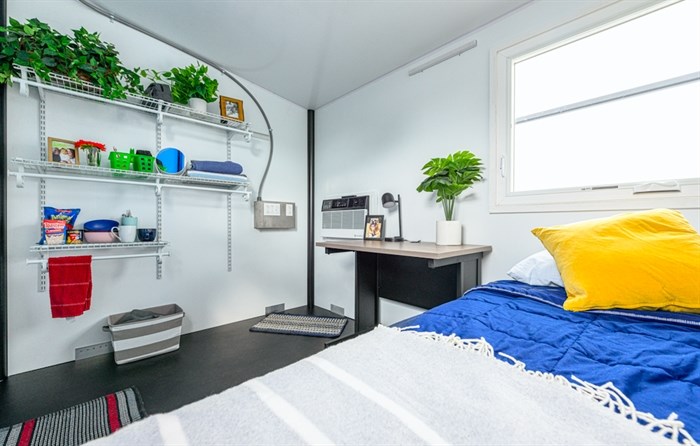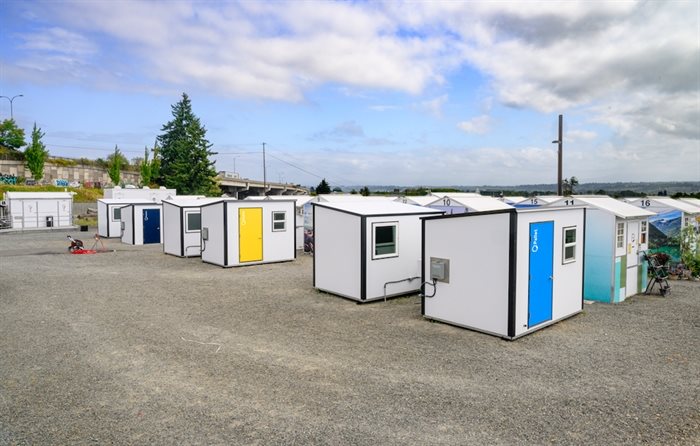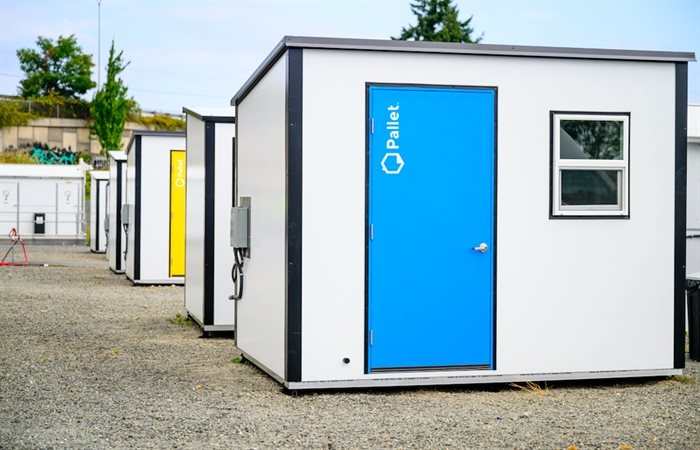Why Kelowna’s homeless don’t get bathrooms in their new tiny shelters
While so-called tiny homes are relatively new as sheltering spaces for the unhoused in BC, Pallet Shelter has been installing them across the United States for seven years.
The Everett, WA company is busy building 120 of the tiny units for two sites in Kelowna, the first 60 of which are expected by early next year.
READ MORE: First tiny homes in Kelowna to be built near Rail Trail homeless camp
So far, Pallet has supplied units for 120 sites – ranging from eight to 200 units per site – in 85 cities and 22 states, as well as Nova Scotia.
Their S2 Sleeper model, which is coming to Kelowna, is 70 square feet with electric heating and cooling systems well suited to Kelowna’s climate and sloping roofs capable of supporting heavy snow loads, Pallet CEO Amy King told iNFOnews.ca. Three larger, 120 square foot units suitable for couples are also being supplied.
These homes are really just sleeping rooms with no bathrooms and no kitchens, for a couple of very good reasons.
“One is, it’s a lot more cost effective for the cities to centralize plumbing,” King said. “It’s really expensive to run plumbing to every single unit in a tiny home village so, unless they’re planning to make the site permanent, that’s really not a worthwhile expense.”
The second reason comes from Pallet's unique operating philosophy where more than half their 80-100 employees have been homeless.
“They told us, if we put bathrooms and kitchens inside the units, then it’s likely folks will consider them a permanent stopping place and they’re likely to isolate in there and not leave and that is not our intention,” King said.
“Pallet products are meant to be used as interim housing as people stabilize and prepare to move on to permanent housing so we want people to have a more temporary mindset. Removing the bathroom actually, believe it or not, helps with that mindset. It helps people recognize this is a good place to stop for now and stabilize. Eventually, they get tired of leaving their units to go to the bathroom and they want to move on to the next thing.”
The bathrooms are not communal but come in two-unit buildings. Each has a locking door, sink, toilet and shower.
Pallet is also providing a laundry room and 400 square foot community room for food distribution.
There are other advantages to these tiny homes, as opposed to typical emergency shelters or being forced to live in tents.
“One of the biggest benefits of this model is that it’s a non-congregate model,” King said. “Everyone has their own space behind a locking door so they can feel safe sleeping at night.
“They don’t have to worry about the spread of illness between residents because everyone has walls between them. They can store their stuff during the day and feel comfortable with it being there because they have a locked door. That’s one of the biggest drawing cards. We have very high adoption rates with this model because of that.”
READ MORE: Kelowna's tiny homes for the home homeless should be standard in BC: Duncan mayor
The units are made out of 100% recyclable fibreglass composite with an insulated core. That means no wood, nothing to rot, no mould and nowhere for bedbugs to hide, King said.
“They are incredibly durable and they have a multi-year warranty on them,” she said. “And they’re really cleanable. You can hose them out. You can pressure wash them and sterilize them between users.”
They come in panels with 16-18 on a tractor trailer. Each takes about an hour to set up before adding in the accessories.
While they are tiny, they do carry a bit of a hefty price tag at about $17,000 USD ($23,000 Canadian).
Pallet builds the units for tiny home villages and doesn’t manage them. They work to make sure buyers adhere to their “dignity standards,” which specify on-site management from a service provider.
“Almost all of our sites are fenced and that’s something we encourage for the security of the residents,” King said. “There will be single or double points of entry so they know who is coming and going from the site for the safety of the people who live there.”
The company is also structured on a model to do more than simply employ some people with experience being homeless.
“We’re a social enterprise,” King said. “We are a for-profit entity but our profits are designated, first and foremost, to our primary mission which is workforce development for marginalized populations.
“We’re a certified living wage employer. We employ people at living wages, train them and teach them on the job. We offer them full benefits and wrap around support services at their place of employment to build and maintain sobriety, to learn construction and manufacturing trades and we teach all kinds of soft skills too – financial and digital literacy, interpersonal relationships, things like that.”
While Kelowna is starting with 120 units on two sites that may only be the beginning as Mayor Tom Dyas has suggested there may be further expansion in the future.
Currently there are about 250 sleeping rough in Kelowna.
To contact a reporter for this story, email Rob Munro or call 250-808-0143 or email the editor. You can also submit photos, videos or news tips to the newsroom and be entered to win a monthly prize draw.
We welcome your comments and opinions on our stories but play nice. We won't censor or delete comments unless they contain off-topic statements or links, unnecessary vulgarity, false facts, spam or obviously fake profiles. If you have any concerns about what you see in comments, email the editor in the link above. SUBSCRIBE to our awesome newsletter here.






